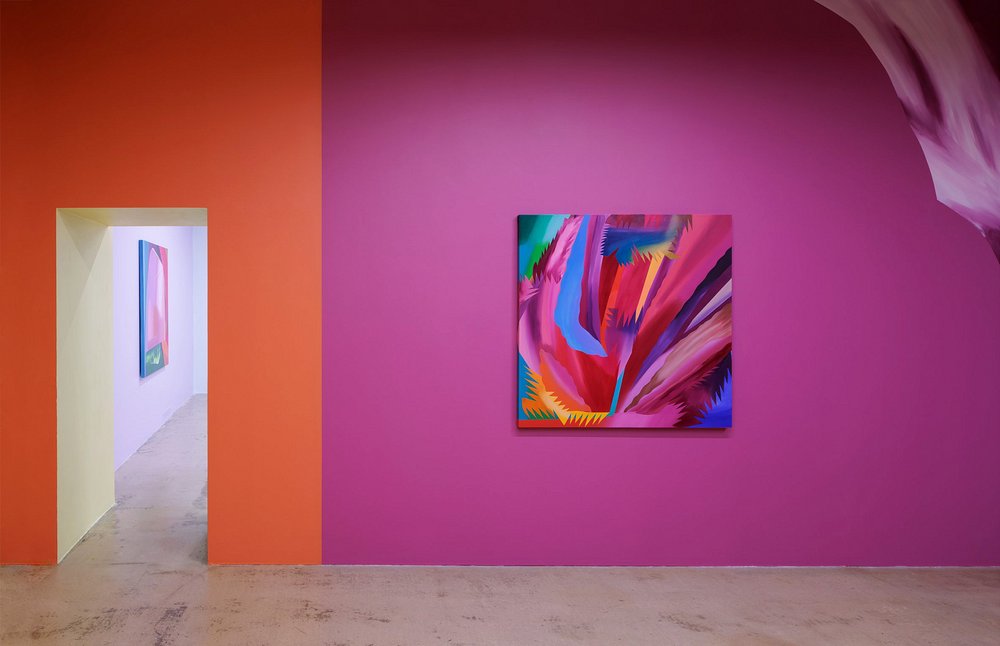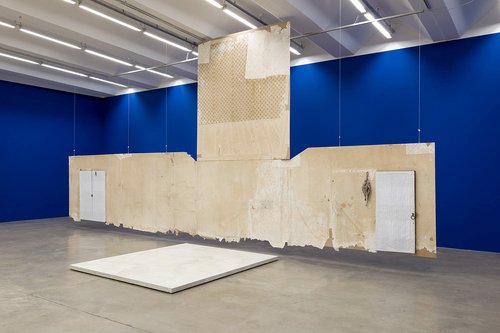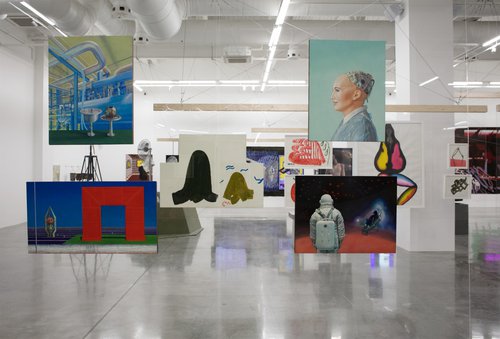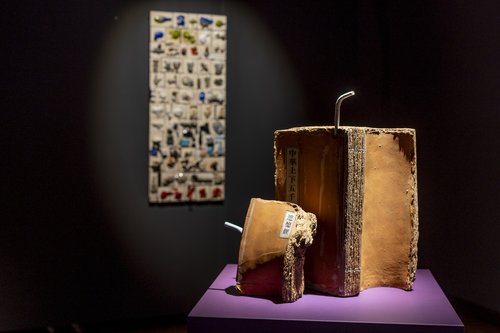Grass Roots and Cosmic Dust: Baltic Art in Search of Common Ground

White Dwarves and All Those Beautiful Nebulas. Exhibition view. Riga, 2025. Photo by Ansis Starks. Courtesy of Kim? Contemporary Art Centre
Amid very real challenges of geopolitics, funding, and identity, some Baltic artists and institutions like ‘Kim? Contemporary Art Centre’ in Riga, currently hosting an exhibition of Estonian art, are advocating new levels of collaboration across Latvia, Estonia, and Lithuania. Russo-British artist and cultural commentator Ariadne Arendt reflects on the potential and the obstacles of uniting contemporary art scenes across the three Baltic countries while respecting cultural diversity and individuality.
In the darkest time of the year when the sun shines sparsely if at all, and snow has not yet stepped in to lighten the winter landscape, a melancholy takes over, ‘Veļu laiks’ or the time of spirits as pagan-inclined Latvians call it, honouring rituals around a connection with the world of the dead. This period hosts a new exhibition at Kim? gallery, with the poetic title ‘White Dwarfs and all Those Beautiful Nebulas’ proffering through these cosmic phenomena a metaphorical imagining of death and rebirth, as represented by three artists from Estonia united by curator Šelda Puķīte.
The three women taking over Riga’s leading contemporary art centre use expressive abstract forms to pull visitors into their parallel universe. Painter Kristi Kongi (b. 1985) dominates the central space with her trademark paintings of dizzying vibrancy, paint escapes the canvases’ boundaries sprawling out radiantly onto the gallery walls. The other two artists, with a room each, are sculptors. Eike Eplik (b. 1982) fills the darkened space with sculptures consisting of porcelain objects resembling creatures, with protruding hair, and physical shadows of metal and paint all accompanied by eerie tingling sounds. Anna Mari Liivrand (b. 1993), possibly the most complex, composes elegant structures hanging from the ceiling with fragments of graveyard fencing, found objects and stained glass. In a poetic language hinting at a potential elusive narrative, the seemingly haphazard and awkward linear objects levitate like abandoned drawings in metal, at once fragile and menacing.
This is part of an ongoing international art exchange between institutions in Latvia and Estonia, the works commissioned by the Kogo gallery in Tartu. As curator Šelda Puķīte says, the darkest times can also be the birthplace of something new: “where there is death there is also life. From their outer layers, white dwarfs create a planetary nebula that erupts into colourful gas clouds, becoming a new star-forming incubator. In other words, it uses the leftovers of the old world to create a new one.” Perhaps metaphorically speaking the dream of new life breaking through the darkness is also a wishful thought for the future of cultural cross-germination between the Baltic countries.
It is art which is both universal and relevant: we are all living in dark and difficult times in terms of geopolitics, the environment and our world economies. The cultural sector has also been severely affected, and its actors, especially those engaged in the organisational and financial aspects are looking around for solutions. It would seem an obvious desire to support one another and find strength in uniting efforts between neighbouring Latvia, Estonia and Lithuania. It is easy to say but what form could this collaboration take and what obstacles might need to be faced?
This autumn Zuzeum, the largest private art museum in the Baltics, felt an urgency to raise this issue, hosting a public talk on the subject ‘Beyond Boundaries: The Baltic Art Journey’ chaired by Olga Temnikova one of the most internationally successful contemporary gallerists from the Baltic region, posing questions to three artists, one from each Baltic country: Anna Škodenko from Estonia, Latvian Andris Eglītis, and painter Gabrielė Adomaitytė from Lithuania. “Can Baltic artists and cultural institutions collaborate effectively to elevate the region’s presence on the global stage?” was the pressing question for Temnikova however the artists themselves seemed to eschew an affirmative answer. Young painter Gabrielė Adomaitytė, based in the Netherlands where she has stayed on after a pivotal residency has been tentatively interested in re-engaging with the Lithuanian art scene but feels more secure of success in terms of representation and sales in central Europe. On the contrary, Eglītis, a household name recently celebrated in a large solo show at Latvian National Museum of Art, spoke about his open-air art space Savvaļa, where he withdraws to the Latvian wilderness as his source of introspective inspiration. Estonian Anna Škodenko feels the tendency to self-identify as Scandinavian rather than Baltic. Where artists do not mind getting involved in or supporting cross-cultural initiatives they do not appear too eager to bear the flag of these cultural politics in reality, which seemingly benefits institutions rather than individual artistic practices.
Estonian artist Maria Kapajeva (b. 1976), who in 2023 took part in Baltic|States, a residency for emerging artists from the region at Baltic, a former flour mill turned centre of contemporary international art in the UK (despite its name there is no direct connection to the Baltic countries). This kind of initiative demonstrates the potential benefit of presenting as a unified Baltic region on the international stage. Yet Kapajeva stresses it is commonly an outsider view that groups the Baltic countries together and while useful at times it can also be superficial. “Certainly there is some commonality geographically and in our shared past of Soviet occupation, however culturally we are also quite different and that is something external observers often overlook in their desire to see us as a whole. This kind of project might start by unifying the region, but then has the potential to present the region’s diversity.”
The suspension of Latvia’s Riboca Biennial criticised for its connection to Russian funds, has been by many accounts a loss to the Baltic art scene. Founded in 2016 with the aim of connecting both Baltic and international artists and placing Riga on the global art map, what better way is there than hosting a biennale to declare yourself as a contemporary cultural powerhouse? However, perhaps, as the Kim? exhibition wants us to believe, new life can sprout from the remnants of a dead star too. And it seems there are processes bubbling up in the form of more horizontal, grassroots initiatives. Perhaps due to the lack of a designated institutional space there is a tendency towards site-specific projects, as exemplified by the impressive Survival Kit festival which takes place each year in Riga, and artist-run spaces are also now becoming popular. Both foster much more direct, hands-on communication between artists, their environment and audiences and perhaps this more authentic kind of production will prove to be a more liberating experience. Artists create small-scale projects free from the need to adhere to institutional agendas or expectations.
Could such grassroots initiatives manifest the notion of a unified Baltic scene, or is that territory only the preserve of institutions? An artist group which explores this very concept is Baltic Lines, a research project which identifies itself as a spin-off from the Rail Baltica project. “Referencing happenings around the Rail Baltica railway construction while activating the discourse around the megaproject as a semiotic device.” They are an exceptional example of a grassroots initiative thinking critically and creatively about the cultural and geo politics of the Baltics. “Latvia, Lithuania, Estonia, and beyond meet in the shared balancing act of trying to do something together. To connect and be friends. And can we even afford not to be friends? Or at least perform a friendship?”
Yet a limited budget only takes you so far, and the problem of cultural funding remains very relevant. Artterritory, a prominent art and culture website founded over a decade ago with the aim of fostering cultural connections between the Baltics, Scandinavia and, at the time Russia (later it was excluded). Its director and editor, Una Meistere, has revealed plans to launch a new publication called H2O which will focus on cultural connections between countries located around the Baltic sea basin, because “not only culture but also water connects us geographically and physically.” Central to the publication will be articles and initiatives around art collecting: “What is the human and aesthetic mission of the collector and their collection in the ecosystem of art and culture? Similarly in the ecosystem of a city, country, region and wider cultural space? And in the development and shaping of this space both today and in the future?” It is hoped there will be a boost to the local market and that it will inspire new collectors.
Ultimately there are many levels and approaches, as many as there are actors and agents in the constantly evolving organism that makes up a community, from large-scale institutional projects, national museums, independent residencies, publications, young galleries, artist studios turned into cultural spaces, research projects, websites and zines. There is no blanket rule or mission that can set the direction of such varying phenomena. One commonality might be an appealing utopia, and in some forms it may find expression, but each initiative must find its own way to interpret or critique this tendency. Any true connections must be made on the ground, through genuine interest and desire. So, what today looks like a fragmented kaleidoscope of small-scale projects, might eventually grow into a fascinating and strong web of artistic output. I look forward to being an observer and participant in this new artistic life.
White Dwarves and All Those Beautiful Nebulas
Riga, Latvia
28 November 2024 – 26 January 2025
















